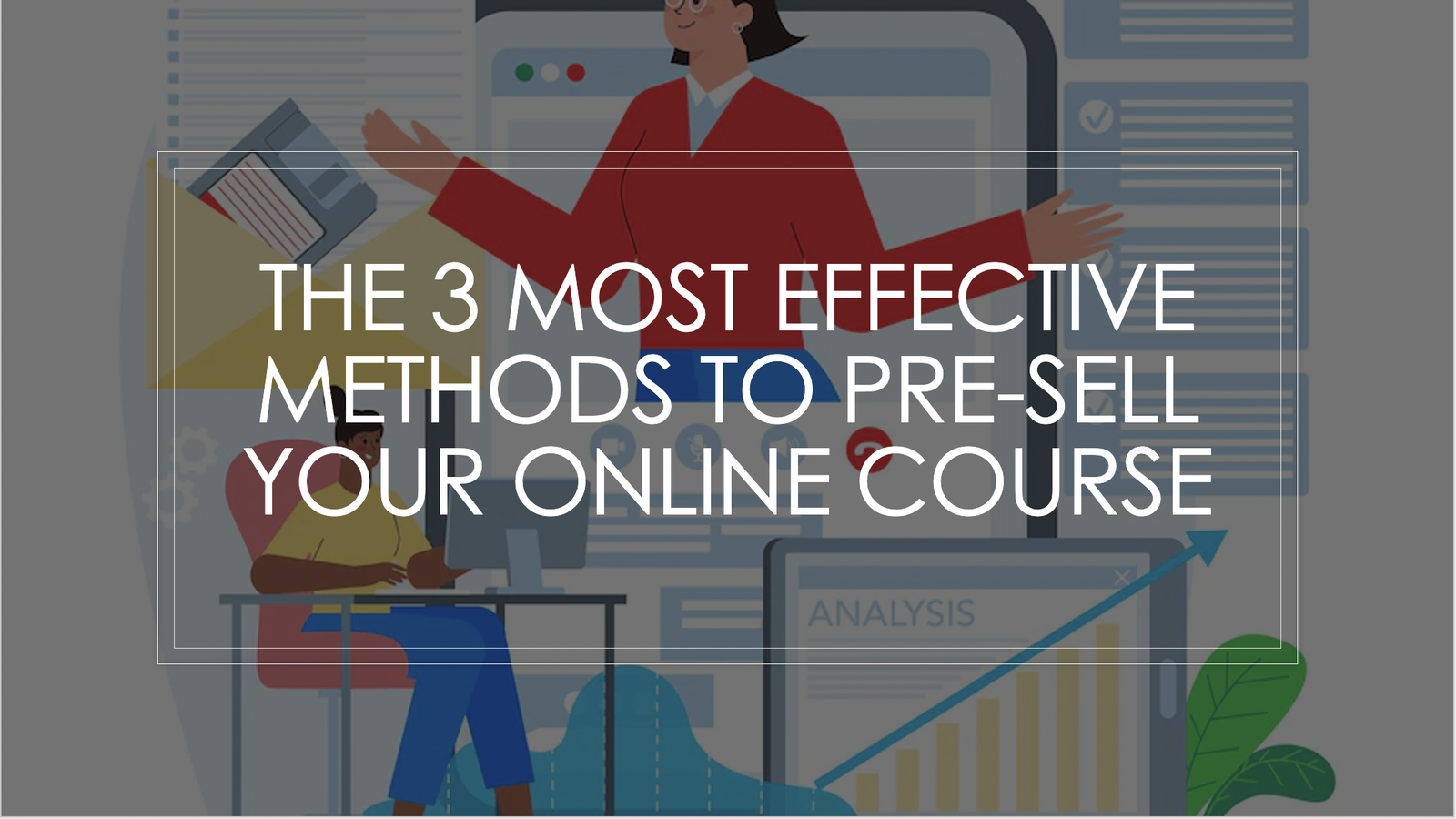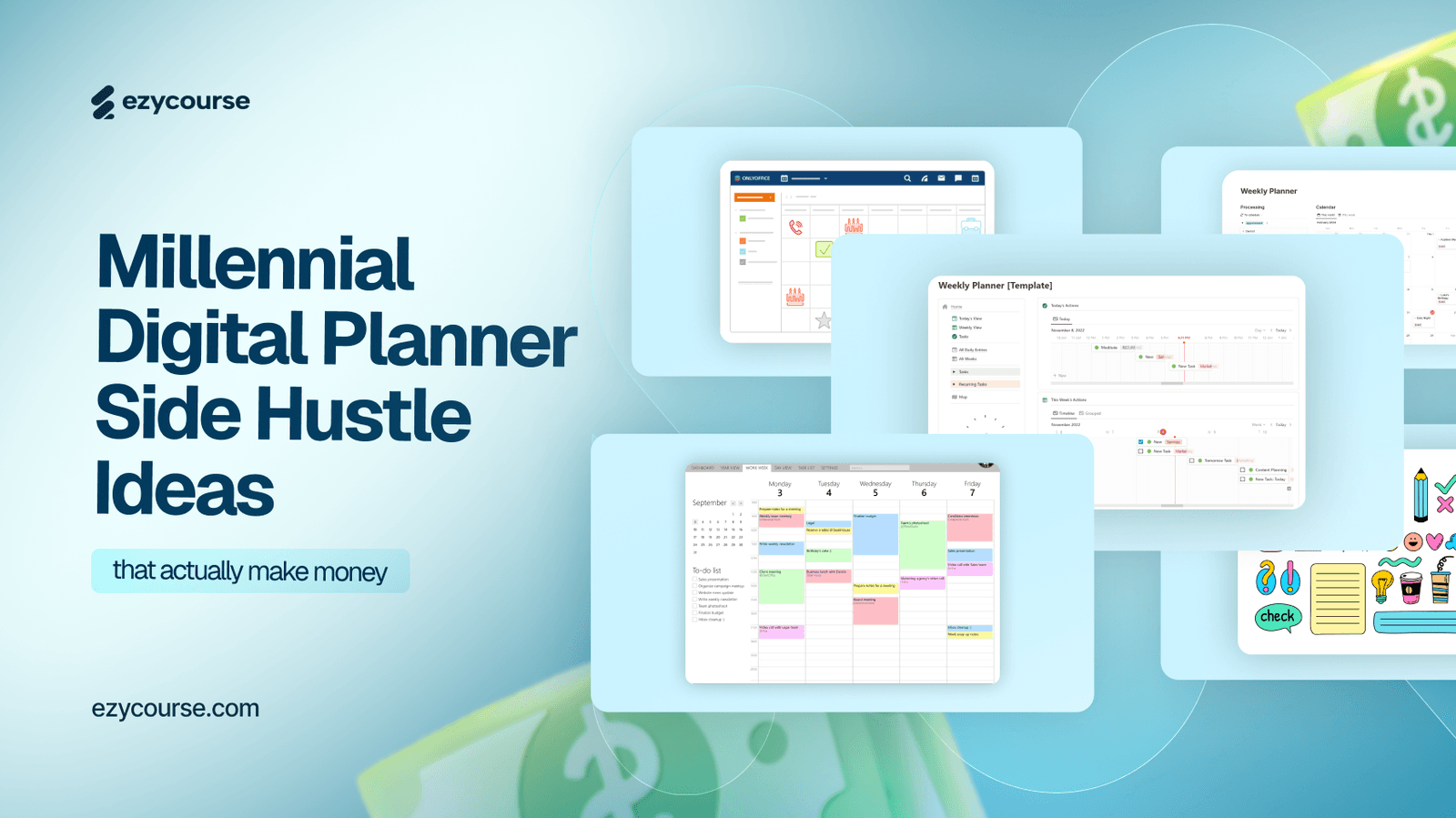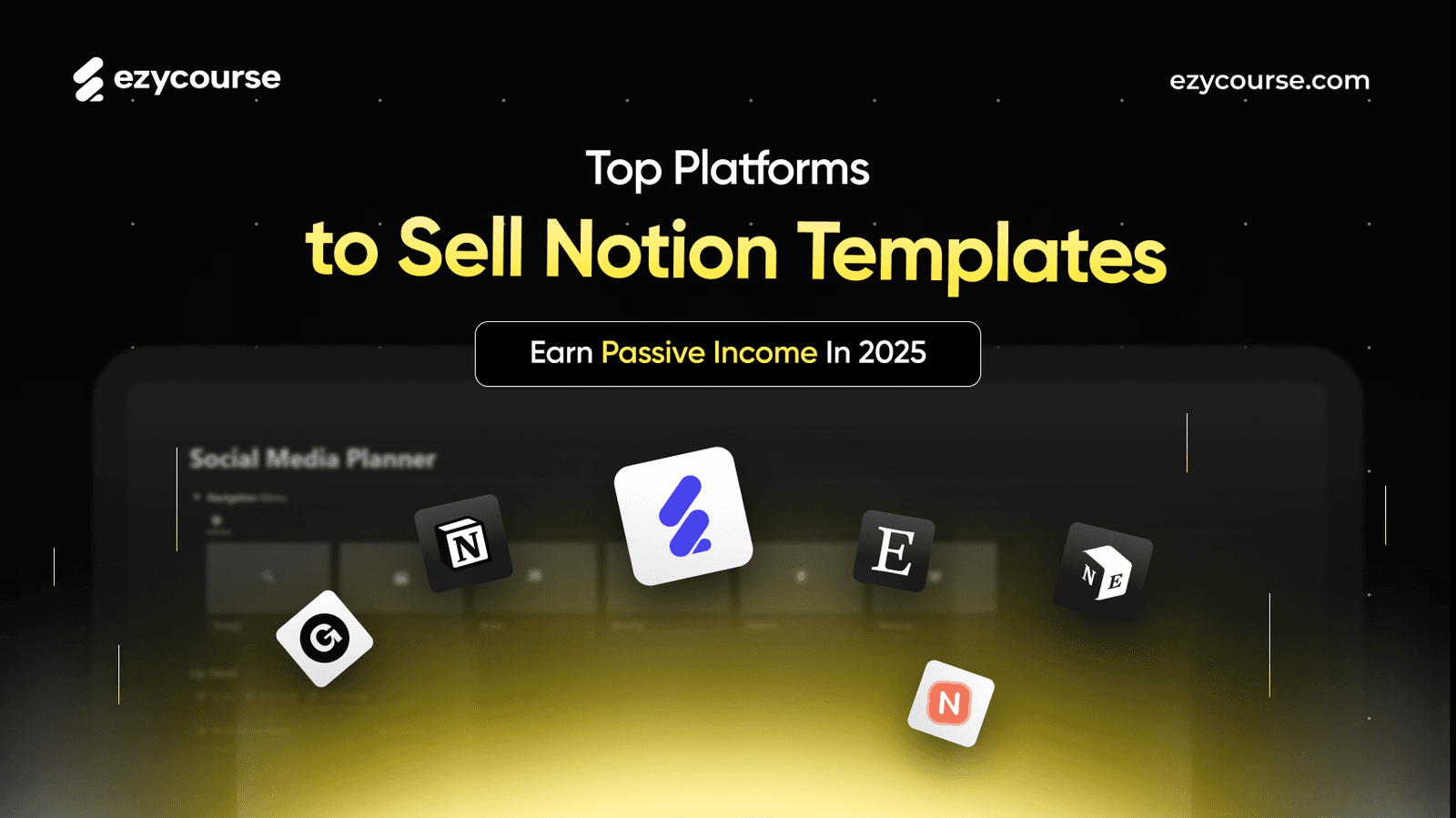You've arrived at the right place if you're wondering how to sell your course before you build it.
Pre-selling online courses essentially means selling a course before it is created, and it is becoming increasingly popular among course creators.
Pre-selling online courses is undeniably effective, but it's a tricky practice unless you're sure what you're doing.
You must be thinking, how do you sell a course before it's created?
Course creators can pre-sell an online course in three ways:
Crowdfunding for your course
Create a beta group.
Create and implement a prototype program.
How to Pre-Sell Your Online Course
We'll discuss how to pre-sell a course the right way soon. But first, you need to decide whether it is the right solution for you and your students.
Each course creator is unique, as is your scenario.
I can't say whether pre-selling is the best option for you, but I can point you on the correct path.
Before further discussion, a little basic knowledge should be needed. Let’s start!
What Does It Mean to Pre-Sell Your Course?
As previously said, there are essentially three ways to pre-sell an online course: crowdfunding, creating a beta group, and launching a pilot program.
All three of these are comparable, yet slightly different. Crowdfunding your course means you post your concept on a website such as Kickstarter and ask people to purchase it before you create it.
Compared to a beta group, where you build some of the course and then test it with a small group of people (who help you refine it as you go).
Developing and releasing a test program is a combination of the two because you pre-sell your course ahead of time and then build it as you go, sharing it with folks inside the program.
They all have one thing in common: they emphasize direct involvement with your pupils and early validation.
Rather than spending weeks or months creating your course, you develop an idea and then implement it gradually. There are some significant advantages to this.
However, it is not the best approach for every course creator.
Should I Pre-Sell an Online Course?
If you are new in this field, you should reconsider the pre-selling course idea.
You are still at the beginning of your journey and there are a lot of unknowns.
As of now, you have no audience, no idea who your ideal student is or how to best serve them, and you have yet to validate your ideas.
Essentially, pre-selling is the ultimate validation of an idea.
Although pre-selling your course focuses on validation and can save you a lot of time if done correctly, it still takes a lot of time, dedication, and work. After all, it is still a debut. There are numerous variables involved, like with any other.
It doesn't mean that pre-selling your first course is impossible; it's simply that there's an added risk owing to all of the other learning curves you're already dealing with: marketing, course production, audience development, and so on.
Many course creators have done it successfully, but you can also focus on validating your idea using some of the same techniques covered in this post, without actually going to the final step of pre-selling.
Pre-selling, on the other hand, may just be what you need to help you streamline your already existing course creation process and take it to the next level if you already have an existing audience and some momentum.
The Advantages of Pre-Selling Your Online Course
Pre-selling your course can be quite beneficial in the appropriate conditions. There are numerous advantages, including:
1. Validate Your Idea
It's one thing to come up with an idea. Is it, however, the right idea? What you believe your students require and what they require may differ.
Even if you think you know your audience well (and you should), you may have mistakenly misinterpreted some of their demands without confirmation.
When building a course, this might be a problem because you can waste a lot of time producing something just moderately good. Pre-selling might help you negotiate this by focusing on what your audience truly requires.
2. Upfront Revenue
Establishing a course involves some level of risk. After all, you're committing several weeks (if not months) to create something that might or might not sell.
Again, pre-selling can assist you to handle this because you get some revenue upfront and ahead of time. It decreases the risk and relieves a lot of strain on your shoulders.
3. Instant Feedback
Because the basis of pre-selling is based on collaboration and feedback, this may be the most significant benefit of all. Before you develop something, you learn what your audience needs.
When you do create it, they provide rapid feedback. It's also one thing for someone to tell you that they think your idea is good.
Another unusual thing is for individuals to pay for your training in advance.
If your proposal is not appealing, most people will hesitate to pay for your training in advance.
But what if they invest some money in your course upfront? That's an entirely different level of feedback.
And if you have a good amount of audience, you are trying to pre-sell your course at a discount but no one buys it? That is also very valuable feedback, indicating that your course concept requires further consideration.
4. Audience Growth
One of the most difficult challenges for a course creator is the constant need to grow and nurture your audience. Everything revolves around the individuals you serve, no matter what business or niche you're in.
So many ways to expand your reach, but finding the ideal one for you can be difficult and also could be costly. Pre-selling can be beneficial in this sense.
If you’re able to pre-sell your online course to at least a few people in a smaller audience, this indicates that your message is well received by them, and you will continue to raise your sales as your audience develops.
However, if you are unable to pre-sell to a small audience, this is an indication that you need to refine your message and make it more relevant to what your audience wants.
Take note that the absence of sales in a tiny audience may just indicate that the audience is still too small. Before drawing any conclusions, I believe you need to have at least a couple thousand people in your audience.
Improving your message in this manner can help you build your audience over time since your content and offer will be much more appealing to your potential students as a result of the feedback you obtained from pre-selling.
5. Accountability
This advantage is significant because pre-selling your course keeps you and your students motivated. Because a group of people paid for your course upfront, you have no choice but to do the work efficiently.
Having received all the feedback, you will feel extra motivated to deliver the best possible course as soon as possible.
How Do You Pre-Launch a Course?
Now that you understand the advantages of pre-selling a course and whether it is the appropriate option for you, the issue becomes, how do you pre-launch a course?
It's actually simpler than you think, and it doesn't cost as much or take as long as you think. However, before you create your course, follow these steps:
1: Outline Your Offer
The first stage in pre-selling is to outline your offer. Not a course description (though a high-level overview is helpful), but rather what your offer will include:
The essential features
The primary advantages of these qualities
Who is your course intended for? (ie: your ideal student)
Price including any bonuses or additional offers
Your course's timeline and what to expect
Also, include a general overview of what your students can expect
It's not necessary to go overboard at this point. The goal is to help you and anyone else on your team or you may hire for this launch stay on track.
At this point, a one-page document will suffice.
2: Create a Plan & Set Clear Goals
In addition to your overview, you should establish some specific goals. Such as:
What do you hope to accomplish by pre-selling your course?
What is the goal of your pre-sell campaign?
How many people do you wish to bring on board?
Finally, describe what constitutes a successful and validated launch.
This is unique to each individual. There is no right or wrong way to set goals as long as they make sense to you. Some may be concerned with the revenue or some maybe revolve around the number of students onboard.
Perhaps you are interested in another critical metric (conversion rate, for instance).
Keep it simple, is my advice. Overwhelming course creators with too many goals is a common problem. They eventually stop being useful. They can rapidly become a hindrance.
You must now devise a strategy.
Likewise, an overly detailed plan is not required. The goal here is to bring your outline to life, once again with a one-page document, by outlining:
The main features, benefits, and other crucial information of your offer
Your objectives and how you intend to track and measure them
Your primary traffic/promotional activities (email, social media, and so on...)
Make a timeline with major milestones and dates.
Generally, this phase assists you in narrowing down your definition of success. It allows you to see what a validated course looks like.
Please do not be one of those creators who skip these steps.
You will have a better chance of success later on if you get organized now.
3: Create Your Pre-Sale Launch Page
After setting the foundation for your pre-sell launch, it's time to implement it, starting with the most important page: your sales page.
Even if you're pre-selling your course, you still need to nail your sales page, as the copy on your sales page is the most important component in determining your conversion rate.
Thus, if you want to master the sales page, you should spend at least a day writing and revising it.
A strong sales page is typically the product of weeks or months of direct community involvement and conversation with your target audience in online forums.
Throughout those interactions, you got to understand your target audience on a deeper level; you know their basic desires and needs, the myths they believe in, and their common misconceptions.
As a result, you can craft a message that resonates with your audience and compellingly speaks to them.
4: Tap into Your Existing Network
Concerned about where to market your course? Your current network should be your first port of call. As a result, once you've created your pre-sell sales page, it's time to contact folks you know:
Friends
Colleagues
Peers
Mentors
Existing students
Keep two things in mind when reaching out to these people:
Partnerships
Social Proof
You can only accomplish so much on your own. You require assistance.
Those already in your network can help you with this.
Perhaps they have their own audience. Perhaps they know someone who would make an excellent student. Perhaps they have a social media following!
To reach out to them and seek partnerships, collaborations, and anything that provides social proof (testimonials, early reviews, etc.).
In addition, contact your current audience and email list (assuming you have one).
Prepare them for what's to come. That is a wonderful way to advertise a course.
Let them know it's coming so they can soon get access before anyone else. Don't give too much information about it.
5: Create a Simple Yet Effective Email Launch Sequence
This represents the final and most important stage in how to pre sell a course. In this section, you must create a short email sequence to advertise your launch. This isn't something you share with your existing email list, but rather something interested parties can join up for.
Study this guide to learn how to make an eye-catching lead magnet. What Makes a Good Lead Magnet for Your Online Courses?
Whatever lead magnet or incentive you choose, the goal is to generate interest in advance of your launch. Once you have a person's email address, you can send them relevant content.
An email sequence like this can be the difference between a successful launch and a failed launch.
The type of emails in this series is determined by you and your target.
We recommend that you keep it simple. A multi-layered funnel is not required for a pre-sell launch. 5-6 emails are often enough. So long as you:
Introduce your offer and specify who it is intended for.
A summary of any features, benefits, pricing, and other important facts.
Share fascinating, relatable stories from other students.
Provide specific instructions on how to enroll and what happens next.
And thus you provide your students with everything they require in the run-up to the launch.
After that, you get them on board, and the real fun begins.
6: Campaign Launch
This is the moment to launch your campaign and welcome your audience. A well-executed course launch will provide you with an extra boost in revenue, students, social media engagement, and overall buzz surrounding the course that you seek.
Conclusions and Next Steps
Pre-selling an online course is a great way to market your course before it's even created if you're still wondering.
It has a lot of advantages over simply filming your course without any direct feedback or engagement from your target audience, as you can see. It is much more likely for your course to meet your student's needs and succeed in the long run if you involve your students in the process from the beginning.
You can also validate ideas without pre-selling, which works well. But the ultimate validation is to ask people to pay you upfront for your course; this is the greatest method to determine whether or not there is a market for your course.
An online course platform, such as EzyCourse, where you can publish your courses, establish a discounted price, and create discount coupons to distribute to your students, is one of the most critical tools you need to pre-sell your course.
So, why wait? Get started for free right now!





